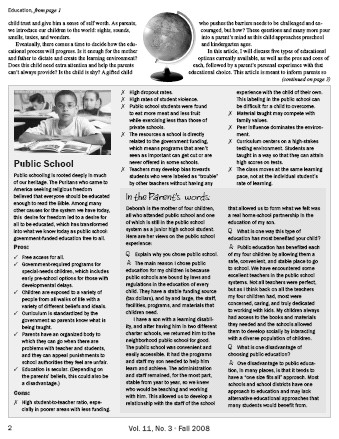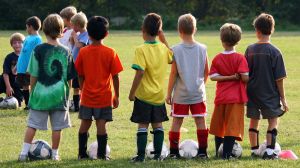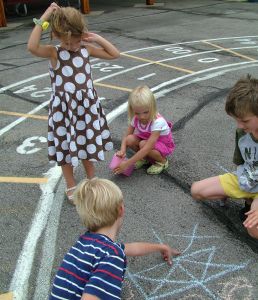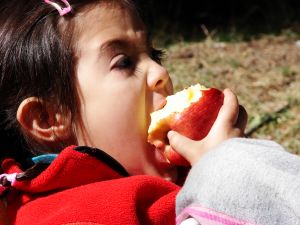By Avril Dannebaum, co-leader of API-NYC
 One morning last summer, as my husband was getting ready to leave for work, I casually mentioned to our 10-year-old son Gerard that today was writing day and that the assignment was 250 to 300 words on his fishing experience during our vacation. “Oh, no! I can’t do it!” he yelled, as he lay down on the couch and proceeded to dissolve into a wet puddle of anxiety.
One morning last summer, as my husband was getting ready to leave for work, I casually mentioned to our 10-year-old son Gerard that today was writing day and that the assignment was 250 to 300 words on his fishing experience during our vacation. “Oh, no! I can’t do it!” he yelled, as he lay down on the couch and proceeded to dissolve into a wet puddle of anxiety.
My husband came back to the living room. I worried that he’d be late, but he took the time to sit down and explain to Gerard that he could definitely write and all it took was an outline. I let him do his stuff. I had been homeschooling our son for almost three years, and both my husband and I knew that Gerard knows how to write an outline. But hearing it from Dad couldn’t hurt.
Eventually Gerard said he just wanted to be left alone. Hubby left for work after I reassured him that our son would be fine, and didn’t he remember what a wonderful 250-word report he had written a couple of weeks ago on our trip to the American Folk Art Museum?
I headed out to our community garden, watered some new transplants, then came in and made my son breakfast. He was still moaning about not being able to write. I told him he had his reading to do first, another chapter of Treasure Island by Stevenson, then math, and then we’d work on the outline together.
Keep balance. It’s hard to stay centered when my son is storming about telling me what he can’t do. Yet I have an idea of what he’s going through. He’s a star in his own personal drama, and I should know because I go through it every time I need to do something important. My process is to ventilate, have a fit of nerves and negativity which I then just have to work through (usually by washing the floor or getting rid of those pesky cobwebs near the ceiling which keep cropping up). And I wouldn’t like it if my husband were to patronize me about my occasional bouts of insecurity. Give the boy his space.
So we get done with algebra, and it’s time to do the dreaded writing assignment. I get out a fresh pad of paper. We talk about the fact that a short essay is usually about five paragraphs. The first one and last one is a given: Introduction and Conclusion. It’s the in between where you have to get a bit creative. We also discussed that 300 words divided by 5 is just 60 words per paragraph. How do you eat an elephant? One bite at a time! We also discussed that, like any other essay, we use the five Ws and H: who, what, where, when, why and how.
As we talk about it, I see him relaxing. I throw out a title, “Fishing Vacation,” and he thinks it’s OK. I start asking leading questions like, “What do you need to go fishing?” “Equipment,” he says. And there is our second paragraph. He lists the things needed, and I scribble them down for him.
Third paragraph is a how-to – something we’ve practiced a lot. He smoothly lists the steps needed to do fishing. I suggest that this is going to be a longer paragraph than 60 words, more like 100 to 125. He agrees. I can tell he’s warming up to the subject.
Paragraph Four: I suggest the “why” of fishing. He replies that it’s fun. “Fun?” I say in mock horror. “It’s not fun for that poor worm. And what about the fish that you’re going to hook?” He gives me a look of real horror, as he sees that there are two sides to this issue.
We don’t say anything about the final paragraph. It’s a conclusion, and he knows how to do those.
I hand him his notes, and he heads to his room to his computer. He asks me to sit with him while he composes. Then he asks, “Can it be fictional?” Sure why not? Suddenly, my son is having a very good time. He’s no longer going to Esopus Creek with his parents. Instead, he’s going by himself to a place called Beaver Creek.
The first paragraph whizzes by, and he asks me to do the word count. Fifty-five words. The second one seems to go a bit faster, and is over 60 words. The third paragraph is 113 words, and he’s laughing to himself. “Here’s the funny part, Mom,” and he reads it out loud to me. It’s humor for 10-year-olds, but that’s what he is, so he loves it.
At this point Gerard realizes that he’s only about 35 words away from the minimum word count. He writes it in one sentence. “I’m done,” he announces. No, you still need a conclusion. “OK,” he shrugs and goes back and writes a bit more, but you can tell, it’s over for him, just an afterthought.
At 285 words, he’s written yet another essay. His formal schooling is over for the day, but there will still be art, music, or exercise in the afternoon. We do three hours of the formal stuff, and then afternoons are free for the soft subjects, and I almost always follow his lead in what he wants.
I ask him why he was so upset this morning. “Well, I forgot what it was like,” he replies. That’s summer for you. Take just a little break, and the anxiety builds.
I’m proud of my son. And I want him to continue to feel the exhilaration of writing and the joy of sharing one’s thoughts on paper. Days like today, when I see him shine…well, I’m just grateful for Attachment Parenting teaching me to do what is right for my family and to follow my heart – something which has included the one-on-one work of homeschooling.
I’m just grateful for Attachment Parenting teaching me to do what is right for my family and to follow my heart.
 I appreciate the effort of the Growing Child issue (The Journal of API, Fall 2008) to focus on the education of our older API-parented children. However, I feel that there was negative bias against public school. The photo selected to represent public school in the article showed unhappy children sitting at their desks without an adult in sight, whereas the other photos for other schooling options showed happy people interacting with each other or actively engaged in work.
I appreciate the effort of the Growing Child issue (The Journal of API, Fall 2008) to focus on the education of our older API-parented children. However, I feel that there was negative bias against public school. The photo selected to represent public school in the article showed unhappy children sitting at their desks without an adult in sight, whereas the other photos for other schooling options showed happy people interacting with each other or actively engaged in work.




